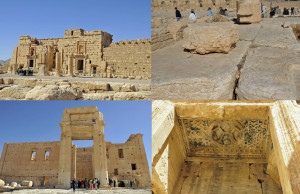For persons living in Syria in the early first century, the most important god was Ba’al (or Bel), who was related to the god whose worship by the Israelites so vexed the Hebrew prophets. Palmyra’s temple to Ba’al was dedicated in 32 A.D., about the same time that Jesus was at the Temple in Jerusalem before his crucifixion. The two temple complexes were very similar. Each had a Roman-style courtyard surrounded by thick colonnaded walls with impressive gates. Each included a tall building near the rear of the courtyard housing a holy of holies that only priests could enter. Each had an altar of undressed stones for sacrificing animals. It is likely that the architects of the Palmyra temple either intentionally drew upon the design of the Jewish Temple or both drew upon a common source. Meticulous reconstruction of Palmyra’s temple that began in 1929 presented a now-lost opportunity to envision the design of the Second Temple, destroyed by the Romans in 70 A.D.
Unfortunately, the destruction of the Palmyra temple is not the first time intolerant religious beliefs have led to the destruction of irreplaceable cultural treasures. For example, early Christians damaged and defaced Egyptian temples because they rejected the beliefs the temples represented. But historical precedents cannot make the malicious destruction of part of the common heritage of humanity any less deplorable.
